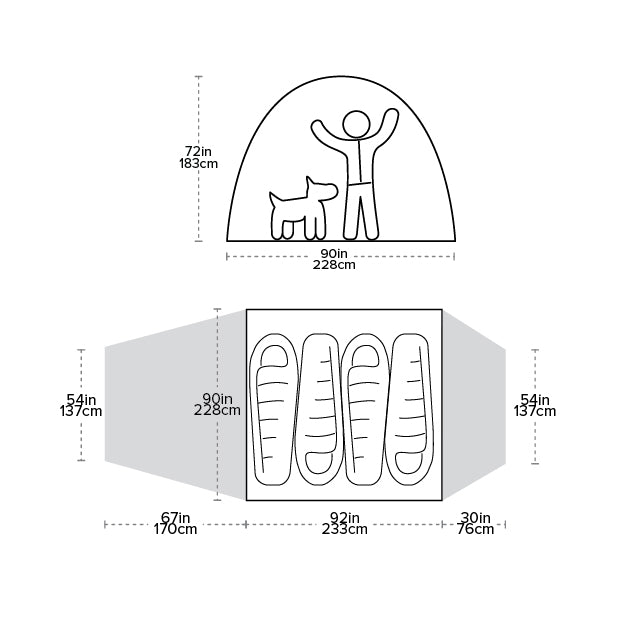- Shop
- Who We Are
- Sustainability
- Support
You’ll be amazed at how the Bunk House tent garners more campground ‘tent-envy’ than anything else pitched. When unexpected wind, rain or a freak June snow storm rolls in, you’ll be glad you pitched this burly double wall tent. Shelter mode lets you pitch it as a covered shelter without the tent body, and the backpack-style carry bag makes lugging gear from the car to the campsite more convenient than ever.
Awards:
Outside - Outside 2024 Summer Gear Guide; Best All-Around For Car Camping



Tent and Footprint Cleaning and Care Instructions:
Storage:
Always make sure your tent is dry and free of debris before storing. Fold and roll your tent a different way each time to avoid permanent creases. Store in a cool, dry place. Never leave your tent in hot temperatures (such as a car trunk or attic space) for long periods of time, as it will damage the material coatings. Storing your tent damp can result in mildew growth, which may cause your tent to smell, leak, or delaminate. Mildew damage is not covered under warranty.
Cleaning:
For light cleaning, sponge the product with warm water (not hot).
For more thorough cleaning you will need:
-Wash basin (or bath tub)-Warm water (not hot)
-Waterproof Gear Cleaner (we recommend products like Nikwax Tech Wash)
-Sponge
1. Submerge your gear in warm, clean water. Gently agitate with hands. Empty dirty water. Repeat until most of the excess dirt/grime is removed and water is mostly clear.
2. Apply waterproof gear specific wash and gently work into fabric with sponge.
3. Rinse gear thoroughly.
4. Hang it up to dry.
5. Triple check that your gear is completely dry before storage or use.
*Do not dry clean or machine-wash. Detergents and dry cleaning solvents will damage the fabric and ruin waterproofing.
*Never use hot water, bleach, liquid detergents, or dishwashing liquids.
*Allow to dry COMPLETELY before storage or use.
*Avoid prolonged direct sunlight as UV exposure can compromise waterproofing.
Seam Sealing:
Big Agnes tents are seam sealed as part of our manufacturing process! This seam tape alone is durable enough to prevent water leakage. Any seams that have been taped do not need to be seam sealed with a liquid sealer unless you want extra protection. Make sure the seam-sealer is completely dry before re-packing your tent. Damage caused by misapplication may void warranty.
Zippers:
Keeping your zippers clean will help keep the coils and sliders from wearing out. If filled with dirt, vacuum or brush zippers before storing tent. We recommend Gear Aid Zipper Cleaner and Lubricant.
Repairs and Warranty:
All Big Agnes tents are guaranteed against manufacturing or material defect. We do not warranty products damaged from normal wear and tear, alteration made by owner, misuse, accidents or damages caused by uses other than intended. Damage due to misuse, normal wear and tear, or improper care may be repaired, at the discretion of Big Agnes, at a reasonable charge. Tents returned for repair must be clean and free of debris.
Questions? Call us or open a support case:
877.554.8975 | support.bigagnes.com
BUNK HOUSE 4 & 6 SET UP INSTRUCTIONS
1. Remove contents from stuff sack. Spread out tent body over desired camp site.
2. Stake out the four corners of the tent.
3. Assemble the poles: one large main poleset with two hubs and one vestibule pole. Ensure each pole section is fully seated into the next by hand instead of allowing the shock cord to snap them together.
4. Insert the pole tips of the main poleset into the grommets at the four tent corners.
5. Attach the plastic clips on the tent body to the corresponding parts of the main poleset. Helpful tip: Unzip both doors and stand inside the unzipped doors when connecting the plastic clips to the poleset for easier reach.
6. Locate the ball cap (pictured below) above each door and attach to the corresponding ball tip on each end of the main poleset ridge pole. At this point you will have a freestanding structure.
7. Drape the rainfly over the tent body, orienting so the colors of the webbing on the rainfly match the webbing on the tent body.
8. Insert the ball caps/pole ends above the doors on the tent body into the pole pockets located on the underside of the rainfly.
9. Attach all hook & loop tabs on the underside of the fly to the corresponding poles for best stability.
10. Feed the vestibule pole through the vestibule pole sleeve and insert the pole tips into the grommets on either side of the vestibule directly beneath the pole sleeve
11. Attach all corresponding plastic clips to the vestibule pole.
12. Ensure the webbing at each corner of the rainfly is completely slackened. Attach the buckles on the corners of the rainfly to those on the tent body.
13. Tighten the webbing on each buckle as needed to keep the rainfly taut.
14. Locate the two webbing loops at the base of the vestibule where it attaches to the tent body and stake them out.
15. Stake out the midpoint webbing loops at the base of both the vestibule pole tips.
16. Stake out the front and rear vestibule doors.
17. Stake out and tension all guylines for best stability, completing set up.
Optional Shelter Mode (footprint sold separately)
Big Agnes footprints enable an alternative structure setup; leave the tent body behind and bring your footprint, rainfly, and poles to create a fast and light, open-air shelter. Footprint sold separately. Helpful Hint: Grab a friend, due to the large size of the Bunk House we recommend doing this with a buddy!
1. Spread the footprint over desired campsite and stake out the four corners.
2. Assemble the poles: one large main poleset with two hubs and a one vestibule pole. Ensure each pole section is fully seated into the next by hand instead of allowing the shock cord to snap them together.
3. Insert the tips of the main poleset into the webbing grommets at the footprint
corners.
4. Drape the rainfly over the poleset, orienting so the colors of the webbing on the rainfly match the webbing on the footprint.
5. Insert the ends of the main pole set ridge pole into the pole pockets located on the underside of the fly.
6. Attach all hook & loop tabs on the underside of the fly to the corresponding poles for best stability.
7. Feed the vestibule pole through the vestibule pole sleeve and insert the pole tips into the grommets on either side of the vestibule directly beneath the pole sleeve.
8. Attach all plastic clips to the vestibule pole.
9. Make sure the webbing at each corner of the rainfly is completely slackened. Attach the buckles on the corners of rainfly to those on the footprint.
10. Tighten the webbing on each buckle as needed to keep the fly taut.
11. Locate the two stake out loops at the base of the vestibule where it attaches to the tent body and stake them out.
12. Stake out the webbing loops at the base of each vestibule pole tip.
13. Stake out the front and rear vestibule doors.
14. Stake out and tension all guylines for best stability, completing set up. Separate 6” large diameter pole segment included for emergency field repair. Slide repair pole over the break to act as a splint. Secure splint in place with tape.
HELPFUL HINTS FOR TENT SET UP
• Our tents are easy to set up but we suggest you practice once at home before using them for the first time to avoid late night bickering with tent mates while fumbling around in the dark.
• Before pitching tent, clear campsite of debris that may pierce tent floor.
• We recommend staking out all corners, vestibules and guylines to increase space and keep your tent from becoming a tumbleweed.
• Hang onto your stuff sacks or they’ll blow away and create backcountry litter.
• Pull on the pole sleeve fabric when inserting poles to avoid any bunching in the material.
• Push rather than pull poles through pole sleeves.
Thanks for choosing a Big Agnes tent!
Please feel free to contact us if you have any questions or comments.
www.support.bigagnes.com
Steamboat Mountain School, formerly known as the Lowell Whiteman School, was founded in 1957 and is located in Strawberry Park, just north of Steamboat Springs. Originally built as a horse barn around 1939, the "Bunkhouse" was transformed into the boys' dormitory. In 2010 after almost 40 years of service, the dilapidated old barn was burnt down. But alumni of the old building can still recall it's glory days, when future-Olympians would take turns skiing off the roof.








